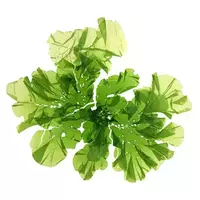Green seaweed

People began to use seaweed for culinary purposes at the initial stage of the birth and development of human civilization. There are three main varieties of seaweed that can be eaten: brown, red, as well as green. Each group of seaweed is distinguished by its appearance, habitat, as well as life cycle, taste and beneficial properties.
The seaweed is green or Chlorophyta belongs to the class of lower plants. It is worth noting that currently the group of green seaweed is considered the largest among all species of marine plants. Researchers count about 20, 000 species of green algae. The interesting thing is that these are inconclusive numbers, since scientists continue to study the oceans and its inhabitants about the present moment.
Green algae species
It is noteworthy that all species of green algae have a characteristic color, which is due to the content of a pigment such as chlorophyll in the chemical composition of plants. Among the edible species of green seaweed, such algae as ulva, umi budo, as well as monostroma and spirulina are considered the most popular and widely known.
However, green beehive algae or sea salad are most often used in cooking. Ulva seaweed got its second name due to its appearance, which is surprisingly similar to lettuce. As a rule, green algae is used in the process of preparing salads, which are usually seasoned with olive oil, lemon juice, as well as balsamic or wine vinegar.
In addition, green algae are suitable for making soups and snacks. It is not uncommon for green algae to dry naturally in direct sunlight. Useful, however, as well as the taste properties of the product are primarily due to the vitamin-mineral composition of green algae.
Composition of green algae
The composition of green algae includes various biologically active components that have a general beneficial effect on the entire human body as a whole. Doctors, as well as nutritionists, recommend introducing seaweed into their daily diet.
What is remarkable is that each variety of green algae has its pros and strengths. For example, spirulina algae contains a large amount of protein of natural origin, and the hive is considered a valuable source of iron. All types of green algae belong to natural antioxidants that help cleanse the body of harmful compounds.
Scientific studies have not found any reliable evidence of the harm of green algae to the human body. However, do not forget that green algae can be harmed by excessive consumption of the product for food. Eating green algae in reasonable amounts will benefit people of all ages.
green seaweed 24.8 kCal
The energy value of green seaweed (Ratio of proteins, fats, carbohydrates - ju):
Proteins: 1.5 g (~ 6 kCal)
Fats: 0 g (~ 0 kCal)
Carbohydrates: 5g (~ 20kCal)
Energy ratio (bj | y): 24% | 0% | 81%
 Español
Español Français
Français Português
Português Русский
Русский 简体中文
简体中文 繁體中文
繁體中文 日本語
日本語 한국어
한국어 العربية
العربية Türkçe
Türkçe Қазақ
Қазақ Deutsch
Deutsch Italiano
Italiano Українська
Українська
